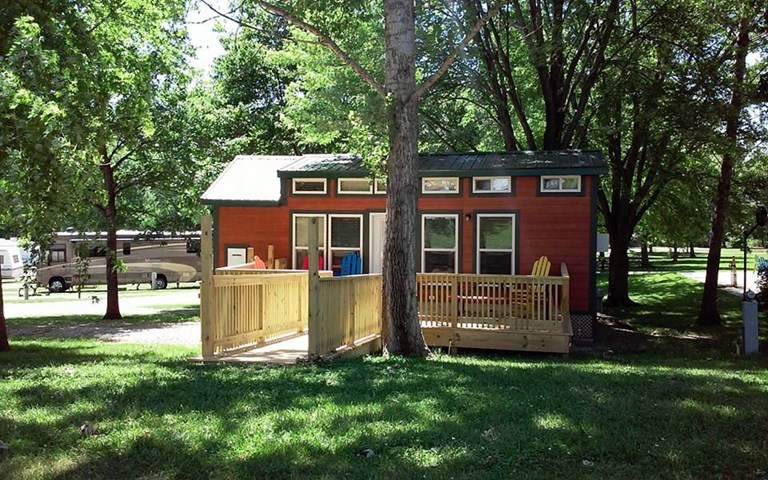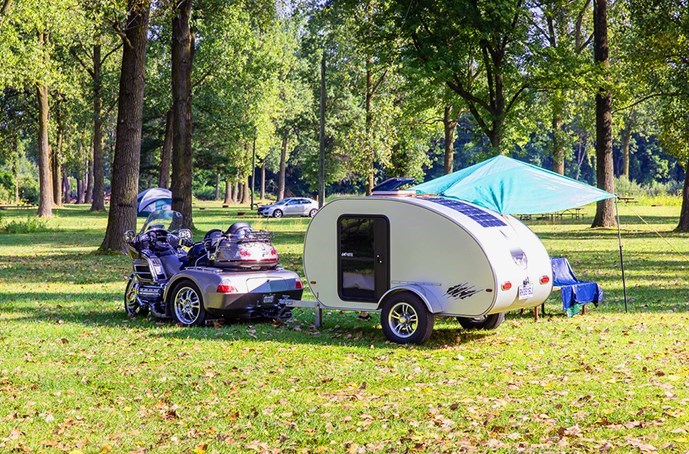Your cart is empty!
Make checkout easy by booking all your reservations at once. Add your sites from different campgrounds into your shopping cart* and then choose checkout.


Reposted from the KOA blog:
With motorcycle ownership on the rise and camping trips growing more popular each year, it was only a matter of time before travelers found a way to combine them. Motorcycle camping enthusiasts have joined their love for the outdoors with the adventure of the open road for truly one-of-a-kind camping experiences.
Motorcycle camping takes different forms — some prefer to ride from state-to-state seeking new places to camp each night, while others bunk down at a single location and explore the area to its fullest. While you can always ride your motorcycle to a campground and seek lodging in a cabin, you might find that some of the best experiences may come from hauling your tent or small travel trailer behind your bike and making camp wherever you go.
Learn more about this unique camping trend, including the differences between types of campers and pull-behind motorcycle trailers and tips for journeying safely.
A motorcycle camping trailer is a small rig you haul behind your motorcycle — sometimes also called a pull-behind trailer — that either carries your tent and supplies or acts as its own shelter when parked. Motorcycle camper trailers are lightweight and compact enough for safe travels, though weight and size vary between models and cargo.
Motorcycle camping is the ideal getaway for solo riders or group travelers. If you are traveling with friends and family, each member of the group will need to tow their own shelter, as motorcycles can typically only haul one trailer or pop-up at a time.
In addition to the more general benefits of camping and spending time outdoors, motorcycle camping offers some unique advantages, including:
Though these advantages are significant, there are a few things to consider before heading out for your first bike trip. Unlike traditional travelers, motorcyclists must always consider the weather — even if it is just a rain shower. Road conditions can get dangerous quickly. Always practice caution.
You will also have far less room in your luggage for some larger camping supplies, like chairs or recreational gear. While most campgrounds have some things available for rent, consider your must-haves before planning your trip.
Finally, motorcycle camping requires experience and patience while navigating. Pull-behind trailers add more weight and length, which may prevent you from using some roads while traveling to the campsite.
If motorcycle camping sounds like the perfect fit for you, the next step is to choose the right camper or trailer for shelter. Your options include open trailers, cargo trailers, pop-up campers and clamshell camper trailers.
Open trailers do not typically have a roof or any type of enclosure beyond four small walls to keep contents onboard. Instead of sleeping in or on the trailer, you use it to haul gear, luggage or even your bike itself if you prefer to drive a vehicle to your campsite and spare your motorcycle the mileage and wear. With an open trailer, you can usually fit several pieces of luggage, camping supplies or a full-size tent — perfect if you like to have more options around your campsite.
Always check the weather before hauling goods in your open trailer, and never forget to secure contents with cords or rope. You can also tie a tarp over your items to keep them drier and more secure.
Cargo trailers have hard, protective shells that encase cargo. They offer more space than your saddlebags alone and keep everything safe from the elements and excess movement. They attach to your motorcycle hitch for low-profile, pull-along hauling. Unlike pop-up or clamshell campers, cargo trailers are not large enough to act as shelters once parked. Instead, use them to pack a tent, tarps, cooking supplies, a hammock or other equipment to set up camp once you arrive.
Cargo trailers are ideal for tent campers who want to combine traditional tent camping with the extra fun and freedom of bringing along your motorcycle.
Instead of hauling a tent, pop-up campers are a portable shelter you assemble when you park at the campsite. These solid platforms are compact and attach to the back of your bike for easy hauling. Once you arrive, simply turn the attached hand crank to “pop” the tent walls and ceiling up for instant shelter.
Some pop-up camper variations include the option to assemble larger tents on top of the platform for more space. Some are more extravagant than others, with room for multiple people and storage.
Clamshell camper trailers are similar to pop-up campers, except there is no crank, and the unit is more self-contained. Once you are ready to set up camp, the bottom and top halves of the hard encasement open like a clam, creating a living space in between. The wedge-like space is protected by tent fabric that attaches to each section to create walls.
Due to the space restrictions that come with the clamshell design, these setups are perfect for solo campers who prefer not to haul and assemble an entire tent.
Before investing in a new or used motorcycle camping trailer for your bike, consider its size, weight, price, features and condition.
Size refers to the width and length of your trailer or pull-behind camper, both when it is compact and full-size. When selecting the right size, consider the following:
The unit weight is one of the most critical factors to consider when shopping for a motorcycle camper or trailer. If it is too heavy for your bike, you will be unable to pull it safely or successfully. Check your motorcycle owner’s manual to learn more about your bike’s curb weight and towing capacity. When accounting for weight, remember to include total rider weight and the approximate weight of the items you will be hauling inside the trailer.
The more weight you tow — and the wider your camper or trailer — the more carefully you must drive:
Price is always important to consider when making an investment. Initial cost depends on several factors, such as:
Remember, the cost of your trailer goes beyond the initial purchase price — you must also account for ongoing maintenance and fuel to haul it.
Trailers and campers may come equipped with different features, depending on which kind you purchase. Possible upgrades include:
If your motorcycle does not already have a hitch installed on the back, check with your bike’s manufacturer for recommendations that will suit your specific model. Make sure the hitch is secure, and haul a test load before you leave on your trip.
Like most bike accessories and equipment, you can buy campers and trailers either used or brand new. While both have their advantages, it comes down to how much money you have to spend on your initial investment, the unit’s condition and your relationship with the seller. Never buy a used trailer from an unknown private seller without bringing along an expert to help you inspect for hidden damages.
When visually inspecting a used trailer or motorcycle camper, check for:
Now that you know how to pick the right motorcycle camper, here are some tips to help you have a successful camping trip:
Some campers seek the thrill of outdoor adventure. Others long for an exciting, urban-fueled getaway with shopping and dining opportunities galore.
Whichever way you choose to travel, some of the best places to visit with your ride are:
With more than 500 North American locations, KOA is never too far from your desired destination.
KOA has everything you need for a memorable motorcycle vacation, including:
Reserve your stay at a KOA Campground today, with Tent Sites, RV Sites, cabins and more to fit any traveler’s needs. Find a KOA near you to get started.
That doesn't mean this area has to always be empty. When you start reviewing camping options, your history will display here to help compare sites and find the best stay. You will be able to share your stay information with friends or family and save it for a later time if you have a KOA Account.
Make checkout easy by booking all your reservations at once. Add your sites from different campgrounds into your shopping cart* and then choose checkout.